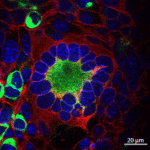Link to Pubmed [PMID] – 29608711
J. Infect. Dis. 2018 Jun;218(1):144-151
Background: A spillover of simian foamy virus (SFV) to humans, following bites from infected nonhuman primates (NHPs), is ongoing in exposed populations. These retroviruses establish persistent infections of unknown physiological consequences to the human host.
Methods: We performed a case-control study to compare 24 Cameroonian hunters infected with gorilla SFV and 24 controls matched for age and ethnicity. A complete physical examination and blood test were performed for all participants. Logistic regression and Wilcoxon signed rank tests were used to compare cases and controls.
Results: The cases had significantly lower levels of hemoglobin than the controls (median, 12.7 vs 14.4 g/dL; P = .01). Basophil levels were also significantly lower in cases than controls, with no differences for other leukocyte subsets. Cases had significantly higher urea, creatinine, protein, creatinine phosphokinase, and lactate dehydrogenase levels and lower bilirubin levels than controls. Cases and controls had similar frequencies of general, cutaneous, gastrointestinal, neurological, and cardiorespiratory signs.
Conclusions: The first case-control study of apparently healthy SFV-infected Cameroonian hunters showed the presence of hematological abnormalities. A thorough clinical and laboratory workup is now needed to establish the medical relevance of these observations because more than half of cases had mild or moderate anemia.
Clinical Trials Registration: NCT03225794.


